The Sources of Sedimentary Organic Matter Traced by Carbon and Nitrogen Isotopes and Environmental Effects during the Past 60 Years in a Shallow Steppe Lake in Northern China
Abstract
1. Introduction
2. Materials and Methods
2.1. Study Area
2.2. Sampling
2.3. Experiments and Methods
2.4. Calculations
3. Results and Discussion
3.1. The Characteristic of Corg%, N%, Corg/N, δ13C and δ15N Distribution in Sediment Profile
3.2. The Sources of Sedimentary Organic Matter in Hulun Lake
3.3. The Environmental Effects during the Past 60 Years in Hulun Lake
3.3.1. Allochthonous Organic Matter
3.3.2. Autochthonous Organic Matter
4. Conclusions
Author Contributions
Funding
Data Availability Statement
Acknowledgments
Conflicts of Interest
References
- Liu, C.; Dong, Y.; Li, Z.; Chang, X.; Nie, X.; Liu, L.; Xiao, H.; Bashir, H. Tracing the source of sedimentary organic carbon in the Loess Plateau of China: An integrated elemental ratio, stable carbon signatures, and radioactive isotopes approach. J. Environ. Radioactiv. 2016, 167, 201–210. [Google Scholar] [CrossRef]
- Rumolo, P.; Barra, M.; Gherardi, S.; Marsella, E.; Sprovieri, M. Stable isotopes and C/N ratios in marine sediments as a tool for discriminating anthropogenic impact. J. Environ. Monit. 2011, 13, 3399–3408. [Google Scholar] [CrossRef] [PubMed]
- Feng, W.; Wang, T.; Zhu, Y.; Sun, F.; Giesy, J.P.; Wu, F. Chemical composition, sources, and ecological effect of organic phosphorus in water ecosystems: A review. Carbon Res. 2023, 2, 12. [Google Scholar] [CrossRef]
- Fornace, K.L.; Whitney, B.S.; Galy, V.; Hughen, K.A.; Mayle, F.E. Late quaternary environmental change in the interior South American tropics: New insight from leaf wax stable isotopes. Earth Planet. Sci. Lett. 2016, 438, 75–85. [Google Scholar] [CrossRef]
- Zhuo, Y.; Zeng, W.; Cui, D.; Ma, B.; Xie, Y.; Wang, J. Spatial-temporal variation, sources and driving factors of organic carbon burial in rift lakes on Yunnan-Guizhou plateau since 1850. Environ. Res. 2021, 201, 111458. [Google Scholar] [CrossRef]
- Chen, F.X.; Fang, N.F.; Wang, Y.X.; Tong, L.S.; Shi, Z.H. Biomarkers in sedimentary sequences: Indicators to track sediment sources over decadal timescales. Geomorphology 2017, 278, 1–11. [Google Scholar] [CrossRef]
- Märki, L.; Lupker, M.; Gajurel, A.P.; Gies, H.; Haghipour, N.; Gallen, S. Molecular tracing of riverine soil organic matter from the central Himalaya. Geophys. Res. Lett. 2020, 47, e2020GL087403. [Google Scholar] [CrossRef]
- Chen, J.; Yang, H.; Zeng, Y.; Guo, J.; Song, Y.; Ding, W. Combined use of radiocarbon and stable carbon isotope to constrain the sources and cycling of particulate organic carbon in a large freshwater lake, China. Sci. Total Environ. 2018, 625, 27–38. [Google Scholar] [CrossRef]
- Lu, L.; Cheng, H.G.; Pu, X.; Wang, J.; Cheng, Q.; Liu, X. Identifying organic matter sources using isotopicratios in a watershed impacted by intensive agricultural activities in Northeast China. Agric. Ecosyst. Environ. 2016, 222, 48–59. [Google Scholar] [CrossRef]
- Tue, N.T.; Hamaoka, H.; Sogabe, A.; Quy, T.D.; Nhuan, M.T.; Omori, K. The application of δ13C and C/N ratios as indicators of organic carbon sources and paleoenvironmental change of the mangrove ecosystem from Ba Lat Estuary, Red River, Vietnam. Environ. Earth Sci. 2011, 64, 1475–1486. [Google Scholar] [CrossRef]
- Qian, J.L.; Wang, S.M.; Xue, B.; Chen, R.S.; Ke, S.Z. A method of quantitatively calculating amount of allochthonous organic carbon in lake sediments. Chin. Sci. Bull. 1997, 42, 1821–1823. [Google Scholar] [CrossRef]
- Nosrati, K.; Govers, G.; Semmens, B.X.; Ward, E.J. A mixing model to incorporate uncertainty in sediment fingerprinting. Geoderma 2014, 217–218, 173–180. [Google Scholar] [CrossRef]
- Stock, B.C.; Jackson, A.L.; Ward, E.J.; Parnell, A.C.; Phillips, D.L.; Semmens, B.X. Analyzing mixing systems using a new generation of Bayesian tracer mixing models. PeerJ 2018, 6, e5096. [Google Scholar] [CrossRef] [PubMed]
- Phillips, D.L. Mixing models in analyses of diet using multiple stable isotopes: A critique. Oecologia 2001, 127, 166–170. [Google Scholar] [CrossRef]
- Li, S.; Xia, X.; Zhang, S.; Zhang, L. Source identification of suspended and deposited organic matter in an alpine river with elemental, stable isotopic, and molecular proxies. J. Hydrol. 2020, 590, 125492. [Google Scholar] [CrossRef]
- Li, Z.; Wang, S.; Nie, X.; Sun, Y.; Ran, F. The application and potential non-conservatism of stable isotopes in organic matter source tracing. Sci. Total Environ. 2022, 838, 155946. [Google Scholar] [CrossRef]
- Moore, J.W.; Semmens, B.X. Incorporating uncertainty and prior information into stable isotope mixing models. Ecol. Lett. 2008, 11, 470–480. [Google Scholar] [CrossRef]
- Parnell, A.; Inger, R.; Bearhop, S.; Jackson, A.L. SIAR: Stable Isotope Analysis in R. 2008. Available online: http://cran.rproject.org/web/packages/siar/index.html (accessed on 2 May 2009).
- Zhang, K.J. Genesis of the Late Mesozoic Great Xing’an Range Large Igneous Province: A Mongol–Okhotsk slab window model. Int. Geol. Rev. 2014, 56, 1557–1583. [Google Scholar] [CrossRef]
- Zhang, K.J.; Yan, L.L.; Ji, C. Switch of NE Asia from extension to contraction at the mid-Cretaceous: A tale of the Okhotsk oceanic plateau from initiation by the Perm Anomaly to extrusion in the Mongol–Okhotsk ocean? Earth-Sci. Rev. 2019, 198, 102941. [Google Scholar] [CrossRef]
- Chen, X.; Chuai, X.; Yang, L.; Zhao, H. Climatic warming and overgrazing induced the high concentration of organic matter in Lake Hulun, a large shallow eutrophic steppe lake in northern China. Sci. Total Environ. 2012, 431, 332–338. [Google Scholar] [CrossRef]
- Li, Z.; Li, X.; Wang, X.; Ma, J.; Xu, J.; Xu, X. Isotopic evidence revealing spatial heterogeneity for source and composition of sedimentary organic matters in Taihu Lake, China. Ecol. Indic. 2020, 109, 105854.1–105854.10. [Google Scholar] [CrossRef]
- Fang, J.; Wu, F.; Xiong, Y.; Li, F.; Du, X.; An, D.; Wang, L. Source characterization of sedimentary organic matter using molecular and stable isotopic composition of n-alkanes and fatty acids in sediment core from Lake Dianchi, China. Sci. Total Environ. 2014, 473–474, 410–421. [Google Scholar] [CrossRef] [PubMed]
- Xu, Z.J.; Jiang, F.Y.; Zhao, H.W.; Zhang, Z.B.; Sun, L. Annals of Hulun Lake; Jilin Literature and History Publishing House: Jilin, China, 1989. [Google Scholar]
- Sun, B.; Li, C.Y.; Zhang, S.; Zhao, S.N. Analysis of Hulun digital basin based on spatial information technology. Environ. Pollut. Control. 2010, 32, 5–19. [Google Scholar]
- Onda, Y.; Kato, H.; Tanaka, Y.; Tsujimura, M.; Davaa, G.; Oyunbaatar, D. Analysis of runoff generation and soil erosion processes by using environmental radionuclides in semiarid areas of Mongolia. J. Hydrol. 2007, 333, 124–132. [Google Scholar] [CrossRef]
- Wang, G. Land Use and Land Cover Change of Hulun Lake Nature Reserve in Inner Mongolia, China: A Modeling Analysis. Exp. Parasitol. 2012, 131, 210–214. [Google Scholar] [CrossRef]
- Liang, L.E.; Li, C.Y.; Shi, X.H.; Zhao, S.N.; Tian, Y.; Zhang, L.J. Analysis on the eutrophication trends and affecting factors in Lake Hulun, 2006–2015. J. Lake Sci. 2016, 28, 1265–1273. [Google Scholar]
- Chuai, X.; Chen, X.; Yang, L.; Zeng, J.; Miao, A.; Zhao, H. Effects of climatic changes and anthropogenic activities on lake eutrophication in different ecoregions. Int. J. Environ. Sci. Technol. 2012, 9, 503–514. [Google Scholar] [CrossRef]
- GB3838-2002; Environmental Quality Standard for Surface Water. State Environmental Protection Administration: Beijing, China, 2002.
- Gao, H.; Zhang, R.; Wang, G.; Fan, Y.; Zhu, X.; Wu, J.; Wu, L. A dam construction event recorded by high-resolution sedimentary grain size in an outflow-controlled lake (Hulun Lake, China). Water 2022, 14, 3878. [Google Scholar] [CrossRef]
- Lu, C.; He, J.; Sun, H.; Xue, H. Application of allochthonous organic carbon and phosphorus forms in the interpretation of past environmental conditions. Environ. Geol. 2008, 55, 1279–1289. [Google Scholar] [CrossRef]
- Meyers, P.A. Applications of organic geochemistry to paleolimnological reconstructions: A summary of examples from the Laurentian Great Lakes. Org. Geochem. 2003, 34, 261–289. [Google Scholar] [CrossRef]
- Kiyokazu, K.; Kurosu, M.; Cheng, Y.; Tsendeekhuu, T.; Wu, Y.; Nakamura, T. Floristic composition, grazing effects and above-ground plant biomass in the Hulunbeier Grasslands of Inner Mongolia, China. J. Ecol. Field Biol. 2008, 31, 297–307. [Google Scholar]
- Wang, Y.T.; Wang, X.; Zhu, G.D.; Zhao, T.Q.; Jia, L.X.; Zhao, M.L. Responses of water and nitrogen use efficiency to stocking raters in C3, C4 plants of stipa-breviflora steppe in Inner Mongolia. Chin. J. Grassl. 2017, 39, 59–64. [Google Scholar]
- Liu, X.Z.; Zhang, Y.; Su, Q.; Li, Z.; Feng, T.; Song, Y. Gradient variation of δ15N values in herbs and its indication to environmental information in the agro-pastoral ecotone in the north of China. J. Univ. Chin. Acad. Sci. 2018, 35, 749–760. [Google Scholar]
- Liang, H. Study on Geographical Distribution Characteristics of Carbon and Nitrogen Stable Isotopes and Elemental of Lake Primary Producers and Zooplankton in Eastern Yunnan. Master’s Thesis, Yunnan Normal University, Kunming, China, 2019. [Google Scholar]
- Last, W.M.; Smol, J.P. Tracking Environmental Change Using Lake Sediments: Physical and Geochemical Methods; Springer: Dordrecht, The Netherlands, 2001; pp. 401–439. [Google Scholar]
- Liu, C.; Li, Z.; Berhe, A.A.; Hu, B.X. The isotopes and biomarker approaches for identifying eroded organic matter sources in sediments: A review. Adv. Agron. 2020, 162, 257–303. [Google Scholar]
- Kendall, C.; Silva, S.R.; Kelly, V.J. Carbon and nitrogen isotopic compositions of particulate organic matter in four large river systems across the United States. Hydrol. Process. 2001, 15, 1301–1346. [Google Scholar] [CrossRef]
- Lee, Y.; Hong, S.; Kim, M.S.; Kim, D.; Choi, B.H.; Hur, J. Identification of sources and seasonal variability of organic matter in Lake Sihwa and surrounding inland creeks, South Korea. Chemosphere 2017, 177, 109–119. [Google Scholar] [CrossRef]
- Evans, R. Overgrazing and soil erosion on hill pastures with particular reference to the Peak District. Grass Forage Sci. 1977, 32, 65–76. [Google Scholar] [CrossRef]

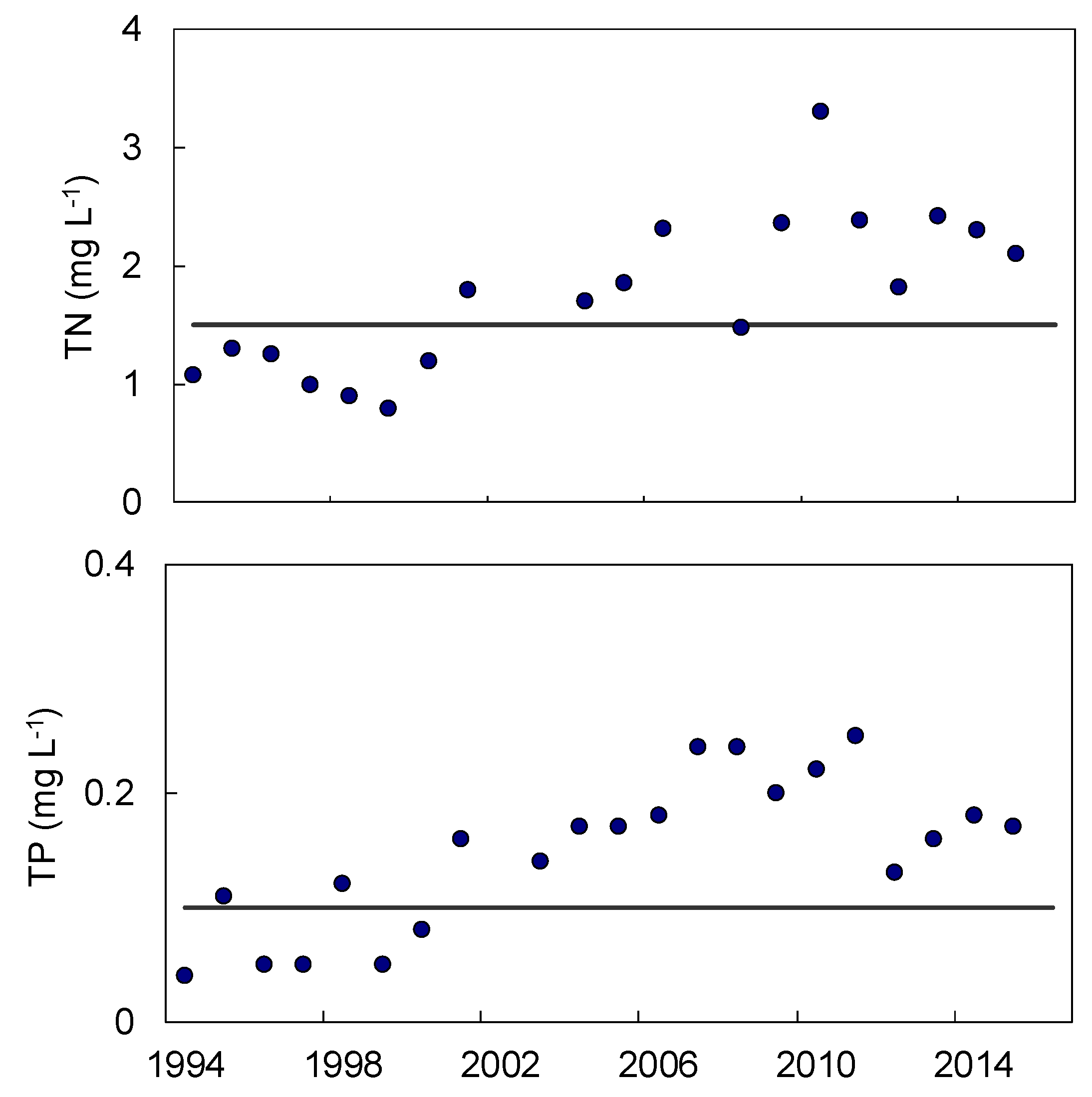

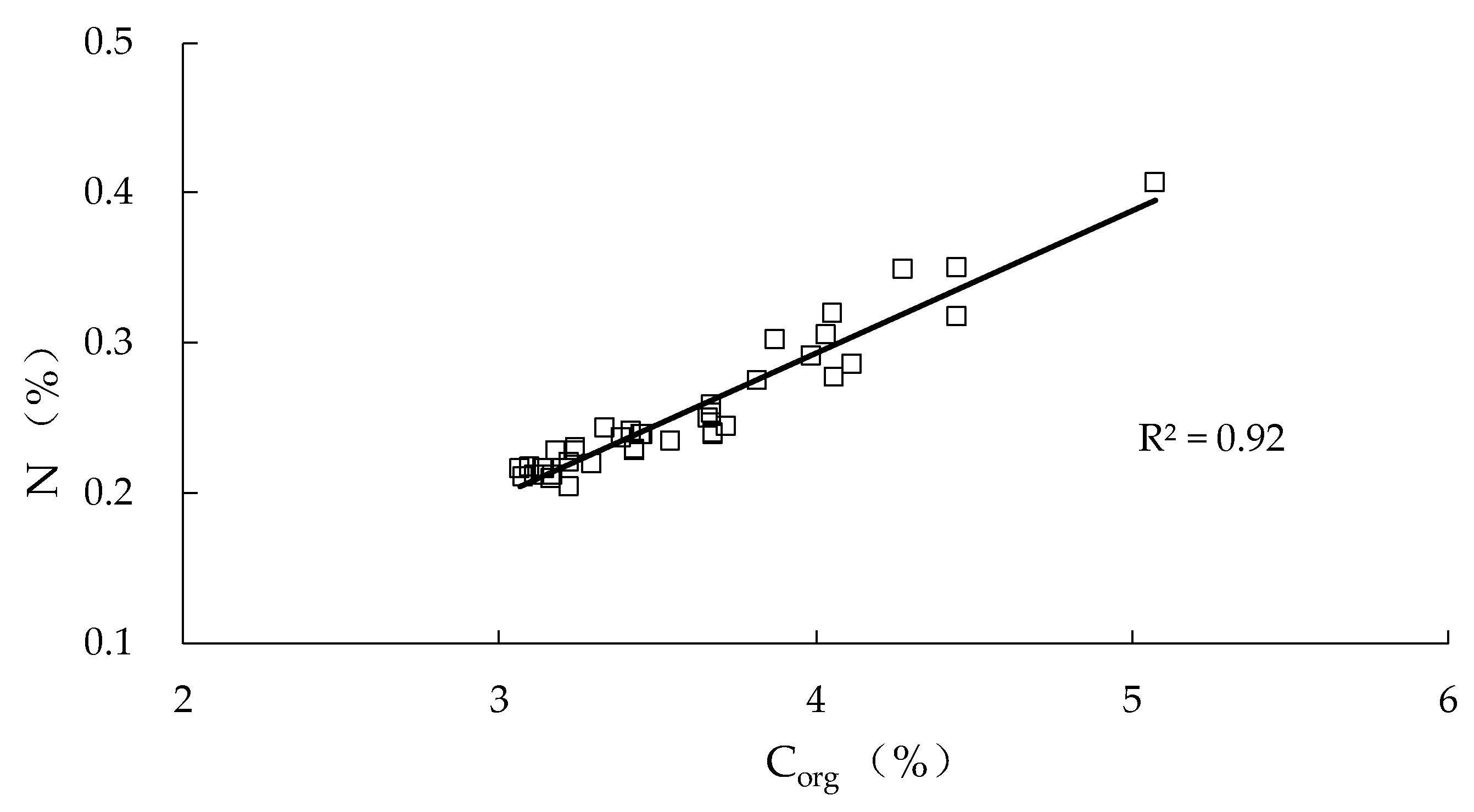
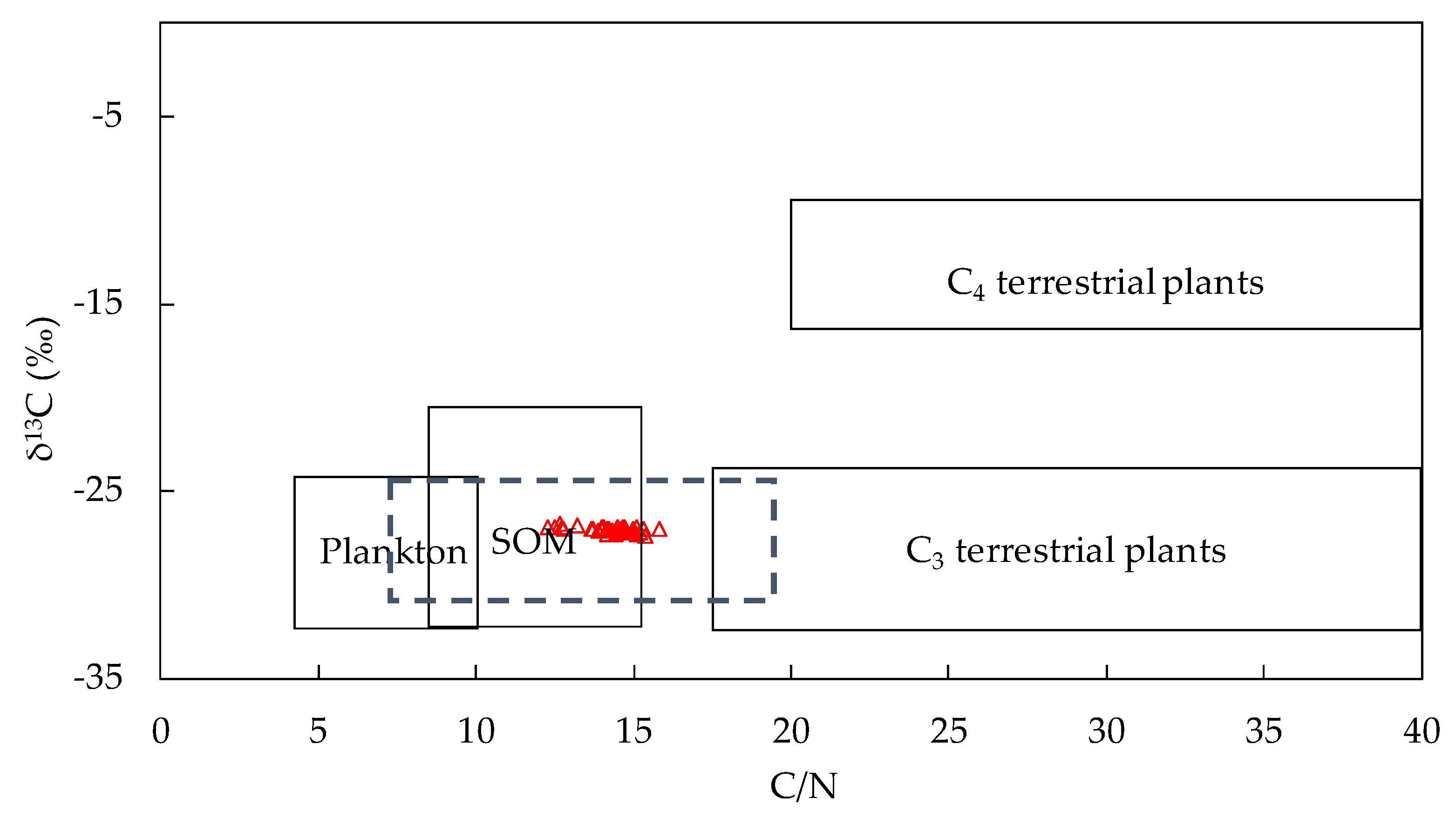
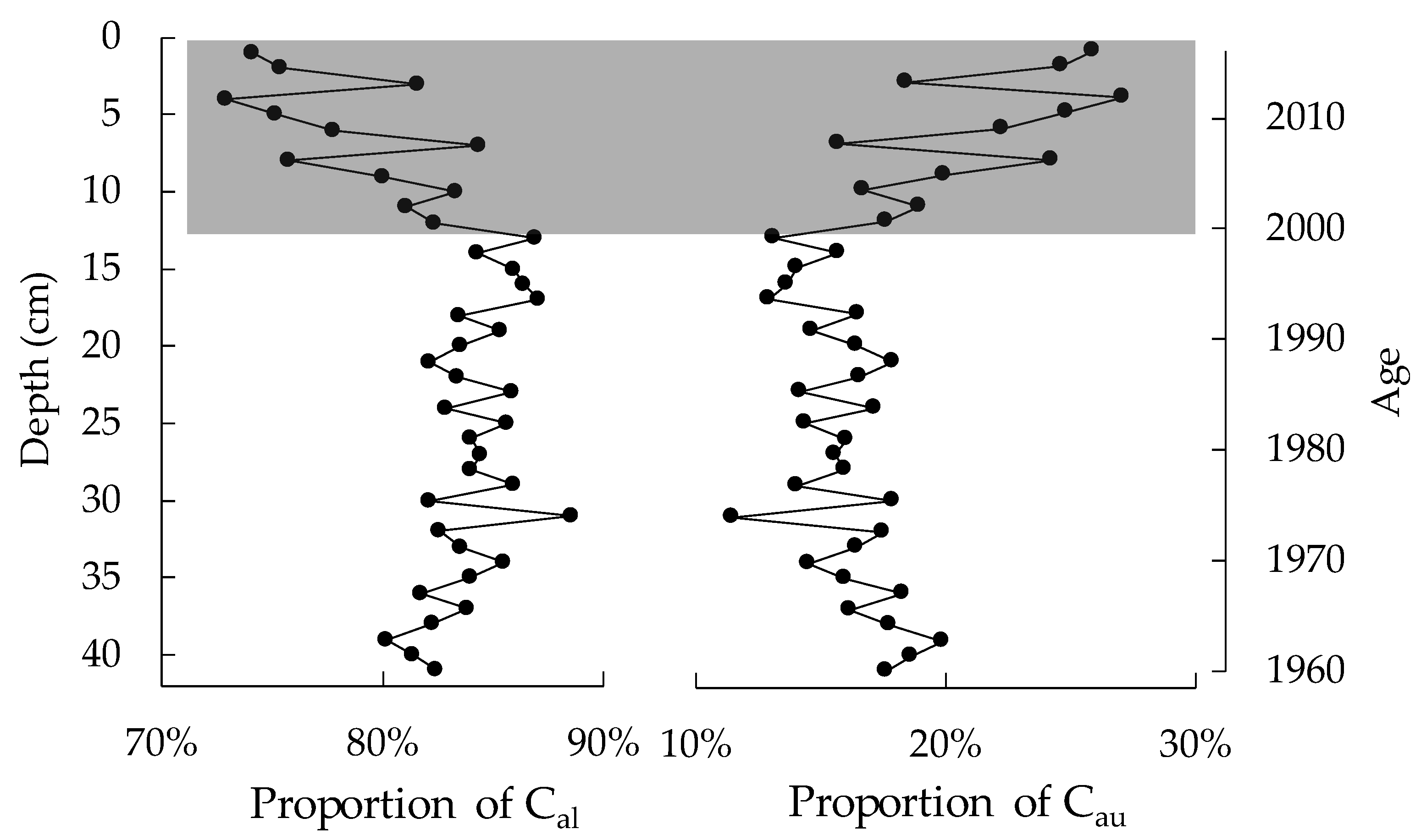


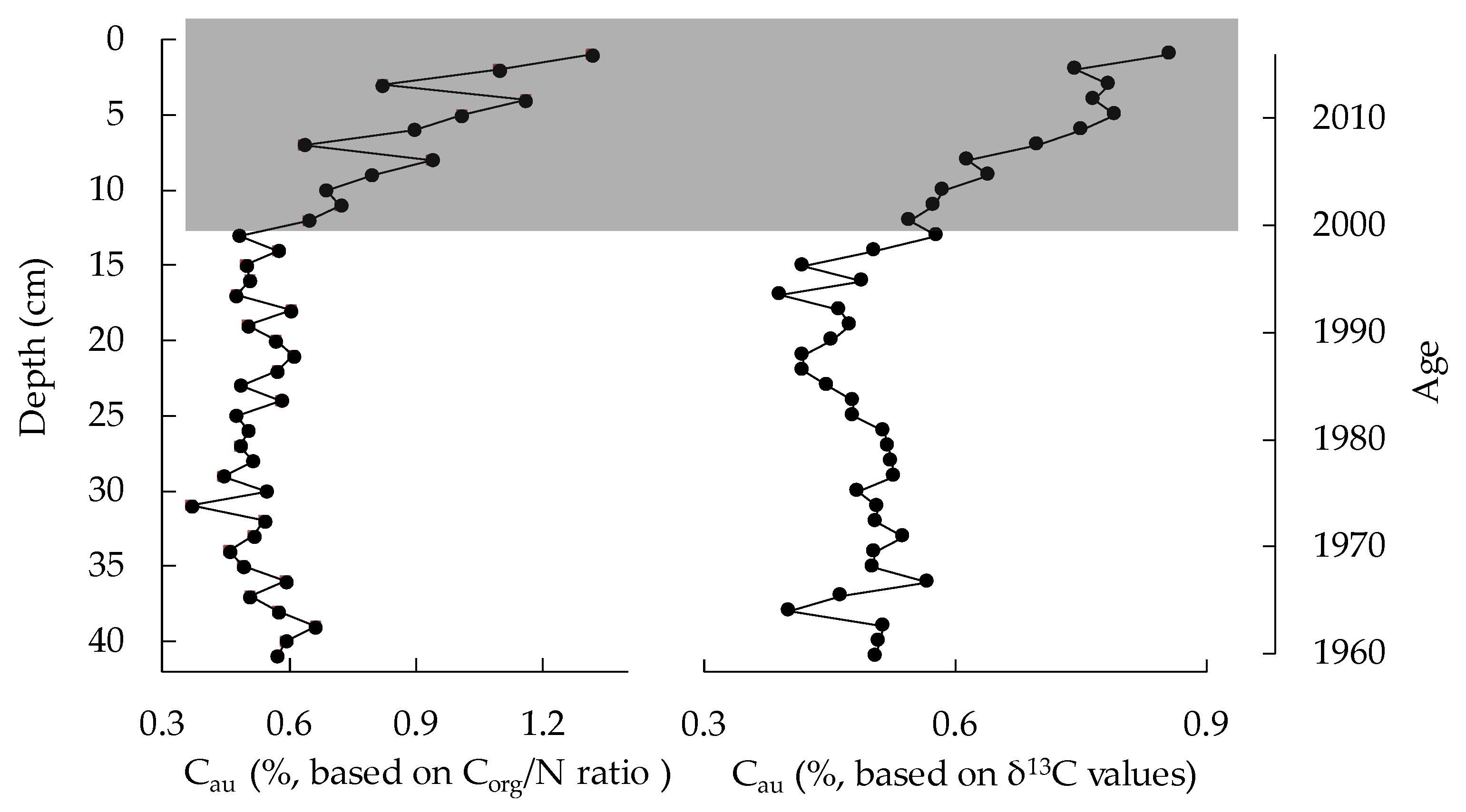
| Source | δ13C | SD | δ15N | SD | Reference |
|---|---|---|---|---|---|
| Terrestrial C3 plants | −28.11 | ±0.12 | 6.20 | ±0.50 | [34,35] |
| Lake plankton | −21.37 | ±2.84 | 9.14 | ±3.51 | [36] |
| Soil organic matter | −26.04 | ±0.29 | 4.74 | ±1.64 | [21,35] |
| Lake phytoplankton | −21.88 | ±2.97 | 7.26 | ±3.83 | [36] |
| Lake zooplankton | −20.85 | ±2.70 | 11.02 | ±3.18 | [36] |
| Samples | Corg% | N% | Corg/N | δ13C | δ15N |
|---|---|---|---|---|---|
| 1 | 5.07 | 0.41 | 12.46 | −26.97 | 6.78 |
| 2 | 4.44 | 0.35 | 12.70 | −26.98 | 6.82 |
| 3 | 4.45 | 0.32 | 13.98 | −26.92 | 7.65 |
| 4 | 4.28 | 0.35 | 12.25 | −26.90 | 6.89 |
| 5 | 4.05 | 0.32 | 12.66 | −26.79 | 6.47 |
| 6 | 4.03 | 0.31 | 13.17 | −26.85 | 6.89 |
| 7 | 4.06 | 0.28 | 14.65 | −26.95 | 6.32 |
| 8 | 3.87 | 0.30 | 12.78 | −27.04 | 7.56 |
| 9 | 3.98 | 0.29 | 13.64 | −27.03 | 7.39 |
| 10 | 4.12 | 0.29 | 14.40 | −27.15 | 7.22 |
| 11 | 3.82 | 0.28 | 13.88 | −27.09 | 7.18 |
| 12 | 3.67 | 0.26 | 14.17 | −27.11 | 7.13 |
| 13 | 3.68 | 0.24 | 15.32 | −27.05 | 7.41 |
| 14 | 3.66 | 0.25 | 14.64 | −27.18 | 7.68 |
| 15 | 3.54 | 0.24 | 15.06 | −27.31 | 7.97 |
| 16 | 3.72 | 0.25 | 15.17 | −27.22 | 7.22 |
| 17 | 3.67 | 0.24 | 15.37 | −27.39 | 7.32 |
| 18 | 3.67 | 0.25 | 14.44 | −27.26 | 7.45 |
| 19 | 3.43 | 0.23 | 14.91 | −27.18 | 6.77 |
| 20 | 3.46 | 0.24 | 14.46 | −27.23 | 7.36 |
| 21 | 3.42 | 0.24 | 14.12 | −27.29 | 7.35 |
| 22 | 3.45 | 0.24 | 14.42 | −27.29 | 6.77 |
| 23 | 3.43 | 0.23 | 15.04 | −27.23 | 6.56 |
| 24 | 3.39 | 0.24 | 14.29 | −27.16 | 6.72 |
| 25 | 3.29 | 0.22 | 14.97 | −27.13 | 6.29 |
| 26 | 3.14 | 0.22 | 14.56 | −27.01 | 6.44 |
| 27 | 3.11 | 0.21 | 14.67 | −26.98 | 6.82 |
| 28 | 3.22 | 0.22 | 14.57 | −27.01 | 6.86 |
| 29 | 3.16 | 0.21 | 15.06 | −26.99 | 6.69 |
| 30 | 3.06 | 0.22 | 14.12 | −27.04 | 6.63 |
| 31 | 3.22 | 0.20 | 15.79 | −27.05 | 7.25 |
| 32 | 3.10 | 0.22 | 14.21 | −27.01 | 7.20 |
| 33 | 3.14 | 0.22 | 14.45 | −26.95 | 7.31 |
| 34 | 3.17 | 0.21 | 14.95 | −27.04 | 7.15 |
| 35 | 3.07 | 0.21 | 14.57 | −27.01 | 7.11 |
| 36 | 3.24 | 0.23 | 14.03 | −26.93 | 7.73 |
| 37 | 3.14 | 0.22 | 14.52 | −27.11 | 7.55 |
| 38 | 3.24 | 0.23 | 14.14 | −27.27 | 7.58 |
| 39 | 3.34 | 0.24 | 13.67 | −27.07 | 6.86 |
| 40 | 3.18 | 0.23 | 13.95 | −27.03 | 6.90 |
| 41 | 3.25 | 0.23 | 14.18 | −27.06 | 5.89 |
| Mean | 3.57 | 0.25 | 14.25 | −27.08 | 7.05 |
| Maximum | 5.07 | 0.41 | 15.79 | −26.79 | 7.97 |
| Minimum | 3.06 | 0.20 | 12.25 | −27.39 | 5.89 |
| SD | 0.46 | 0.05 | 0.82 | 0.13 | 0.45 |
| Source | Mean | SD | 25% | 50% | 75% | 95% |
|---|---|---|---|---|---|---|
| Terrestrial C3 plants | 0.760 | 0.081 | 0.711 | 0.775 | 0.823 | 0.868 |
| Soil organic matter | 0.139 | 0.100 | 0.061 | 0.119 | 0.197 | 0.334 |
| Lake phytoplankton | 0.069 | 0.029 | 0.050 | 0.071 | 0.091 | 0.115 |
| Lake zooplankton | 0.032 | 0.024 | 0.013 | 0.027 | 0.046 | 0.079 |
Disclaimer/Publisher’s Note: The statements, opinions and data contained in all publications are solely those of the individual author(s) and contributor(s) and not of MDPI and/or the editor(s). MDPI and/or the editor(s) disclaim responsibility for any injury to people or property resulting from any ideas, methods, instructions or products referred to in the content. |
© 2023 by the authors. Licensee MDPI, Basel, Switzerland. This article is an open access article distributed under the terms and conditions of the Creative Commons Attribution (CC BY) license (https://creativecommons.org/licenses/by/4.0/).
Share and Cite
Gao, H.; Fan, Y.; Wang, G.; Li, L.; Zhang, R.; Li, S.; Wang, L.; Jiang, Z.; Zhang, Z.; Wu, J.; et al. The Sources of Sedimentary Organic Matter Traced by Carbon and Nitrogen Isotopes and Environmental Effects during the Past 60 Years in a Shallow Steppe Lake in Northern China. Water 2023, 15, 2224. https://doi.org/10.3390/w15122224
Gao H, Fan Y, Wang G, Li L, Zhang R, Li S, Wang L, Jiang Z, Zhang Z, Wu J, et al. The Sources of Sedimentary Organic Matter Traced by Carbon and Nitrogen Isotopes and Environmental Effects during the Past 60 Years in a Shallow Steppe Lake in Northern China. Water. 2023; 15(12):2224. https://doi.org/10.3390/w15122224
Chicago/Turabian StyleGao, Hongbin, Yanru Fan, Gang Wang, Lin Li, Rui Zhang, Songya Li, Linpei Wang, Zhongfeng Jiang, Zhekang Zhang, Junfeng Wu, and et al. 2023. "The Sources of Sedimentary Organic Matter Traced by Carbon and Nitrogen Isotopes and Environmental Effects during the Past 60 Years in a Shallow Steppe Lake in Northern China" Water 15, no. 12: 2224. https://doi.org/10.3390/w15122224
APA StyleGao, H., Fan, Y., Wang, G., Li, L., Zhang, R., Li, S., Wang, L., Jiang, Z., Zhang, Z., Wu, J., & Zhu, X. (2023). The Sources of Sedimentary Organic Matter Traced by Carbon and Nitrogen Isotopes and Environmental Effects during the Past 60 Years in a Shallow Steppe Lake in Northern China. Water, 15(12), 2224. https://doi.org/10.3390/w15122224






